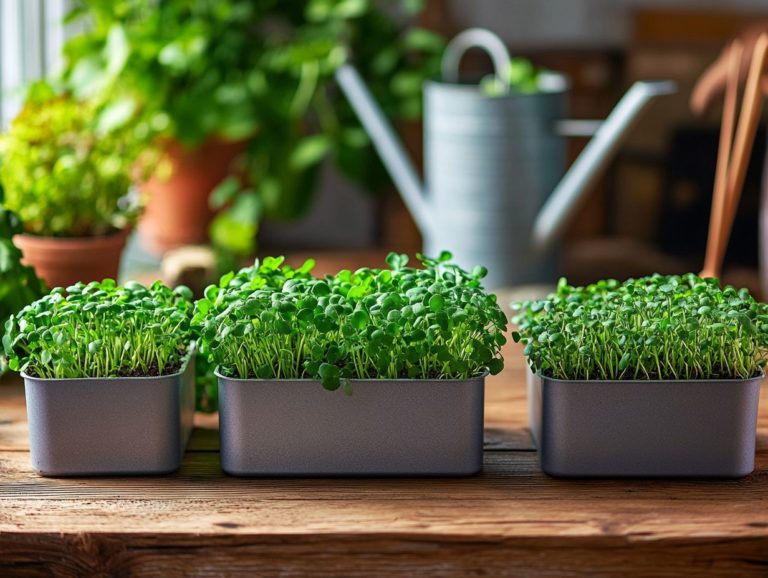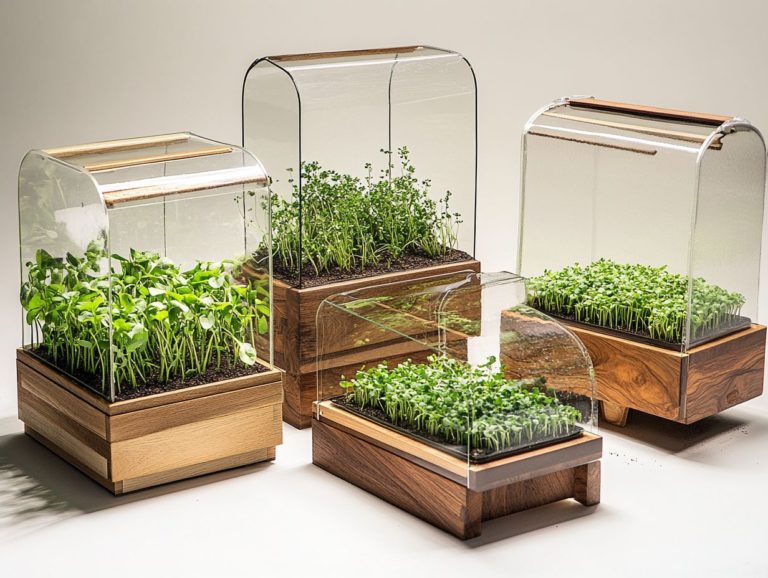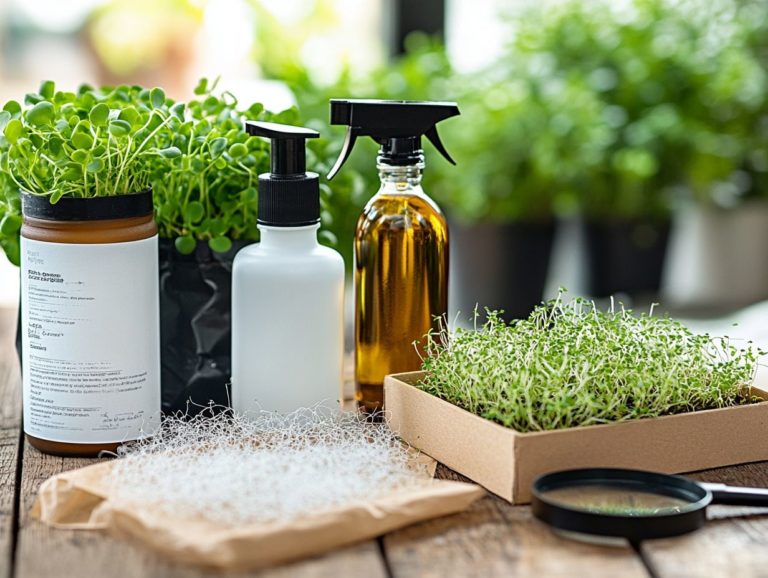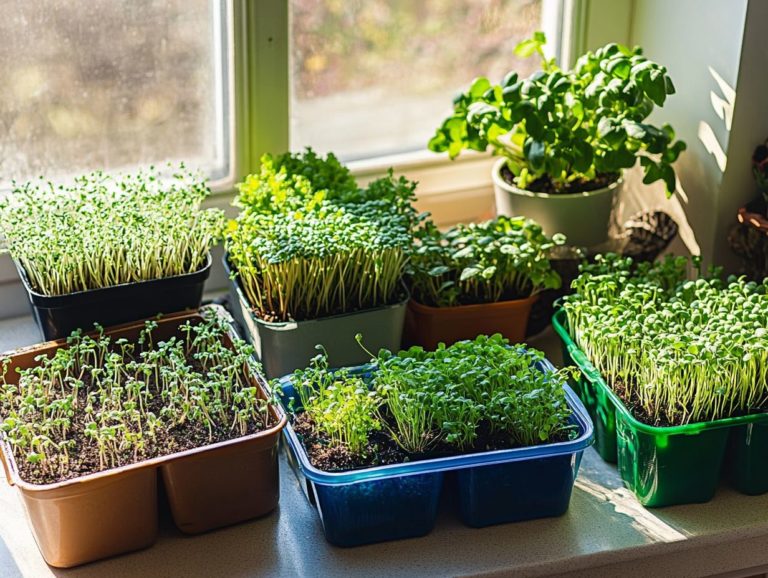Best Microgreen Growing Guides and Books
Microgreens are tiny, nutrient-dense plants that can elevate the flavor and visual appeal of any dish you create.
Whether you’re an experienced gardener or a novice just dipping your toes into the world of cultivation, growing microgreens is both accessible and immensely rewarding.
This guide will provide you with all the essential knowledge, from selecting the perfect varieties to harvesting and storing your greens with finesse.
You’ll also discover insights into common pests, valuable tips for success, and resources for expanding your understanding further.
Get ready to elevate your cooking game with vibrant microgreens!
Contents
- Key Takeaways:
- 2. Choosing the Right Microgreens to Grow
- 3. Supplies and Equipment Needed
- 4. Preparing the Growing Medium
- 5. Planting and Germination Process
- 6. Caring for Your Microgreens
- 7. Harvesting and Storing Your Microgreens
- 8. Common Pests and Diseases
- 9. Tips for Success
- 10. Best Microgreen Growing Guides
- 11. Best Microgreen Growing Books
- 12. How to Incorporate Microgreens into Your Diet
- 13. Benefits of Growing and Eating Microgreens
- 14. Frequently Asked Questions about Microgreens
- Frequently Asked Questions
- What are microgreens?
- What are microgreens?
- What are the best microgreen growing guides?
- What are the best microgreen growing books?
- What should I look for in a microgreen growing guide or book?
- Can I find free microgreen growing guides and books online?
- Are there any recommended courses or workshops for learning how to grow microgreens?
Key Takeaways:
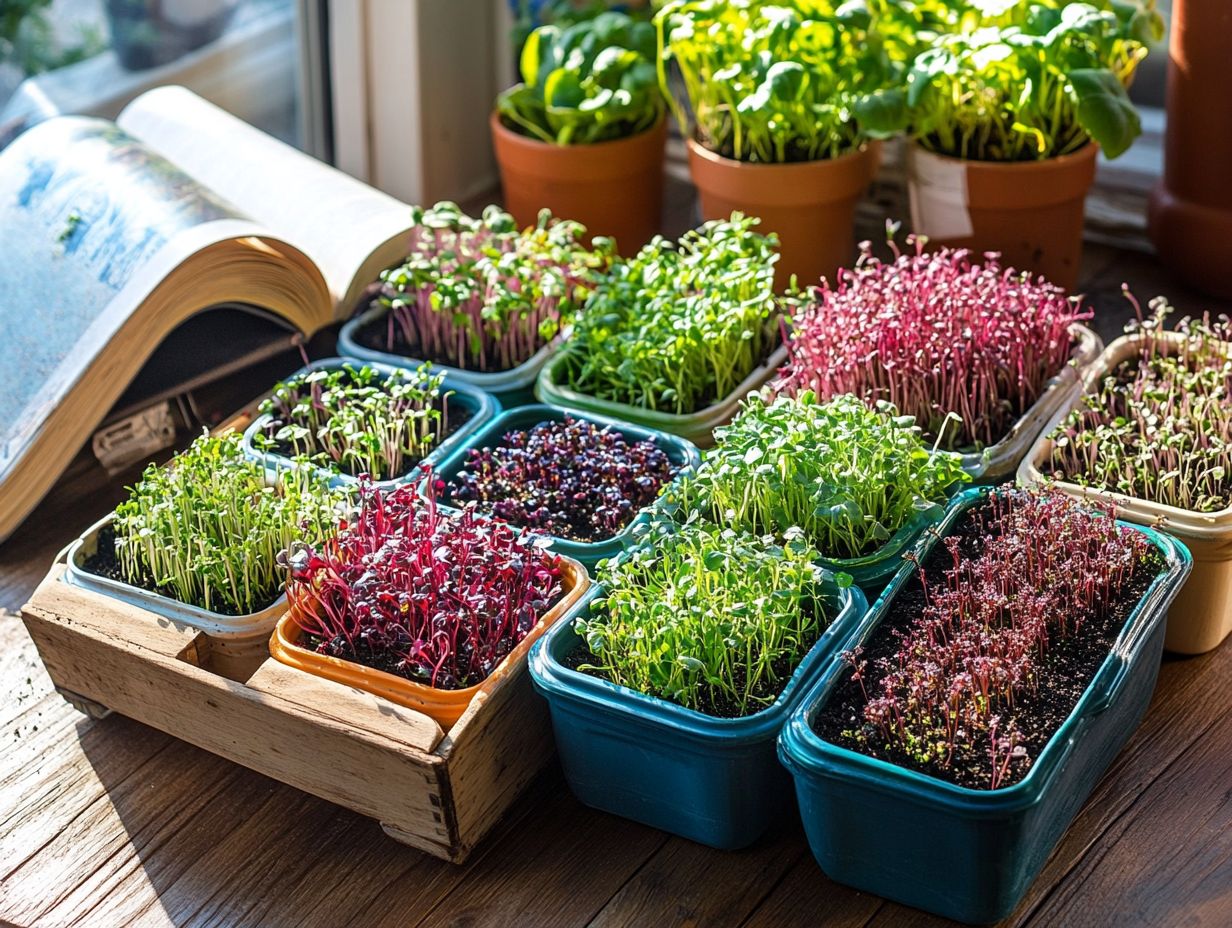
- Start with the right microgreens for your growing space and personal preferences!
- Proper care and harvesting techniques are crucial for successful microgreen growth!
- Utilize comprehensive guides and informative books to learn about the benefits and uses of microgreens in your diet!
2. Choosing the Right Microgreens to Grow
Selecting the finest microgreens for your indoor garden requires a deep dive into the unique flavors and nutritional benefits of popular varieties like Amaranthus, Basil, and Broccoli. You can also explore the delightful potential of adding edible flowers to your project.
When you re choosing microgreens, consider their flavor profiles. Additionally, think about their impressive nutritional benefits and ease of cultivation. For example, Amaranthus offers a subtly sweet, earthy taste, making it an excellent choice for enhancing salads or wraps.
Basil, with its fragrant, peppery notes, can elevate dishes like pasta or pesto to new heights. Broccoli microgreens, on the other hand, are vitamin powerhouses with a mild flavor that seamlessly complements a variety of meals.
While the ease of growth can vary among species, many thrive in straightforward indoor setups. This enables you to enjoy fresh, nutritious greens throughout the year. By selecting the right varieties, your kitchen can transform into an exciting canvas for healthy, flavorful creations.
3. Supplies and Equipment Needed
To start growing microgreens, it s essential to gather the right supplies and equipment. You ll need grow lights, suitable growing mediums, and high-quality microgreen nutrients that ensure optimal growth across various systems, including hydroponics a way of growing plants without soil.
Selecting the right supplies can greatly improve the quality of your crops. For example, grow lights provide the bright, full-spectrum illumination needed to mimic sunlight crucial for photosynthesis, especially in indoor settings.
When choosing a grow medium, consider options like coconut coir, peat moss, or specialized seed-starting mixes. These are ideal for the microgreen business, offering excellent drainage and nutrients to ensure your young plants thrive.
Hydroponics systems present a soil-free growing method that can lead to rapid growth, highlighting the importance of tailored nutrients. If you re just starting out, researching and sourcing materials locally can save you costs while enhancing sustainability. This makes your microgreens growing experience both rewarding and efficient.
4. Preparing the Growing Medium
Preparing the growing medium is a crucial step in your journey to cultivate microgreens successfully. It plays a significant role in nutrient availability and water retention, with choices ranging from soil sprouts to hydroponics. All options harmonize with sustainable gardening practices.
Each medium comes with its own set of advantages and challenges that can affect growth rates and flavor profiles. For instance, soil sprouts offer a rich, organic base that retains moisture, making it a go-to option for beginners seeking successful yields.
However, it’s essential to manage them carefully, as they can invite pests or diseases if neglected. In contrast, hydroponic methods embrace a soilless approach, granting you precise control over pH levels and nutrient balance.
This can lead to faster growth and higher yields, but be prepared for a bit more initial setup and ongoing monitoring to maintain sustainability and efficiency.
5. Planting and Germination Process
The planting and germination process is crucial for successful microgreen cultivation. Knowing the steps empowers you to achieve consistent and healthy growth.
First, select a suitable container. Pay attention to seed spacing for optimal air circulation and nutrient absorption.
A depth of about 1 to 2 inches of growing medium provides ample support for your young plants.
Once you’ve sown the seeds, use a gentle misting technique. This keeps the soil moist without risking overwatering, which can cause rot.
Maintain conditions between 65 to 75 F and provide indirect sunlight to help your seeds flourish.
Consider using a humidity dome to retain moisture. Regularly check for growth signs, like emerging cotyledons, to know when to reduce humidity.
This careful attention will set the stage for a thriving microgreen garden.
6. Caring for Your Microgreens
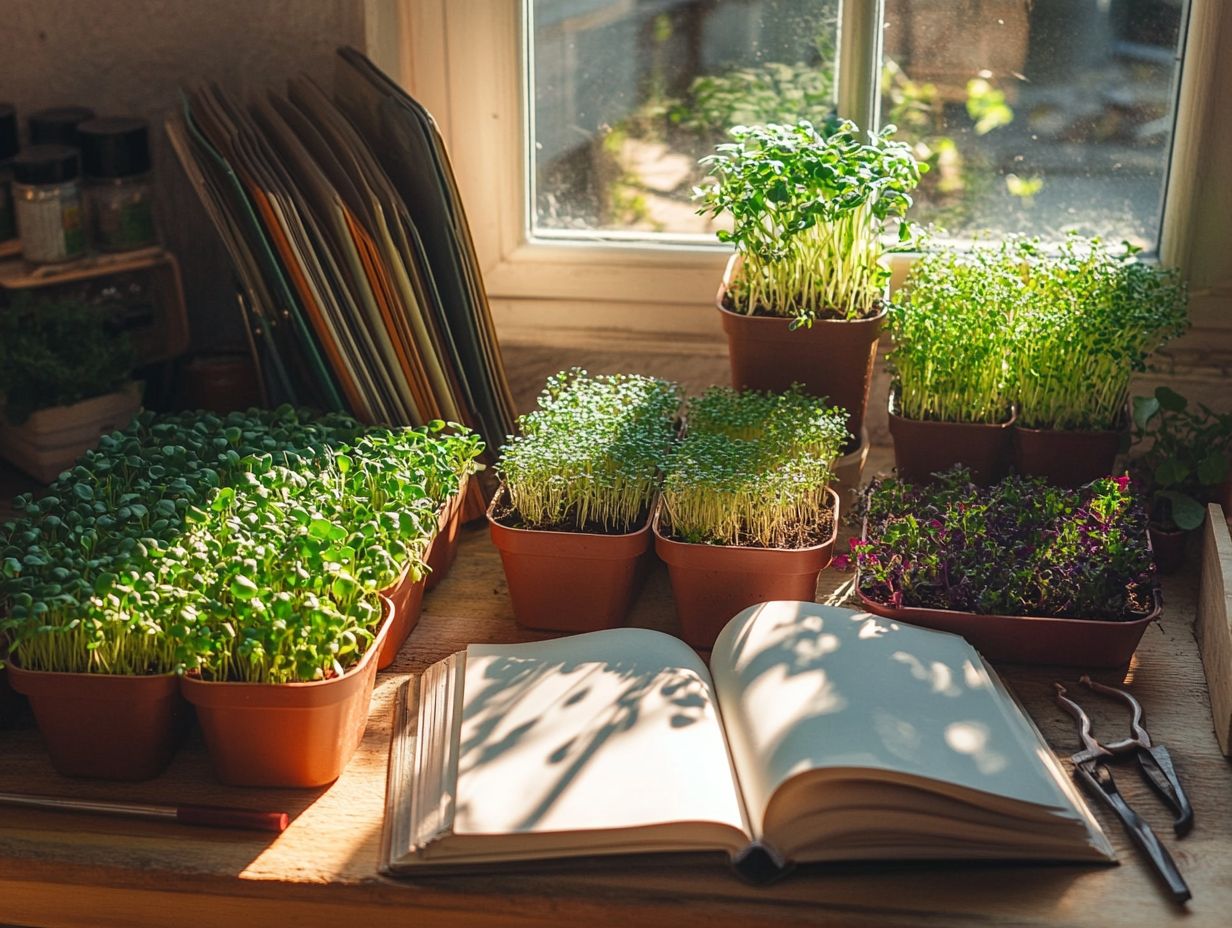
Caring for your microgreens ensures vibrant growth and nutritional quality. Focus on balancing their nutrient needs and maintaining optimal indoor gardening conditions.
Regularly monitor moisture levels. Keep the soil consistently damp but never waterlogged.
Providing the right nutrients is crucial. A diluted fertilizer solution supports growth once seedlings reach a certain stage.
Adjust light exposure based on the variety of microgreens. Some varieties need more sunlight than others.
As your microgreens grow, watch for temperature and humidity changes. You may need to increase watering or relocate them for better light access.
Every small adjustment can significantly impact their growth journey.
7. Harvesting and Storing Your Microgreens
Proper harvesting and storing of microgreens preserves their vibrant flavor and nutritional benefits. Follow this guide to keep them fresh.
These nutrient-packed greens not only boost health but also enhance various dishes with their burst of flavor.
To harvest, use clean, sharp scissors to snip the stems at soil level. Avoid pulling the plants; this reduces damage and allows remaining microgreens to grow more.
Gently rinse them in cold water to remove soil or debris. For storage, place microgreens in a breathable container, such as a perforated bag.
Aim to keep them at a temperature between 32 F to 40 F. This helps your delicate greens stay crisp and flavorful.
8. Common Pests and Diseases
Recognizing common pests and diseases is crucial for maintaining a robust microgreen crop. Sustainable gardening practices can significantly reduce these risks.
Stay vigilant for signs of infestation. Look for discolored leaves, tiny holes, or visible insects.
Identifying these indicators early allows you to act quickly. Common pests include:
- Aphids
- Whiteflies
- Fungal infections like downy mildew
Implement preventive measures such as crop rotation and ensuring proper air circulation. Use organic solutions like neem oil or insecticidal soap.
Regular monitoring and prompt action will help you cultivate a thriving garden.
9. Tips for Success
Achieving success in growing microgreens requires expert guidance and practical tips tailored for you. This ensures your journey is enjoyable and sustainable.
Start with varieties that match your taste, like sunflower and radish. They offer fantastic flavors and impressive nutritional benefits!
Timing matters! Sowing your seeds at the right moment boosts growth and yield significantly.
Tackle challenges like mold and low moisture directly. Ensure proper air circulation and balanced watering habits to avoid pitfalls and enjoy a plentiful harvest of vibrant microgreens.
10. Best Microgreen Growing Guides
Navigating the world of microgreen cultivation can be enriched by exploring the finest growing guides, such as *Year-Round Indoor Salad Gardening* and *The Complete Guide to Edible Wild Plants*. These invaluable resources cater to both beginners and seasoned gardeners.
For home growers, these guides emphasize sustainable gardening practices and the best microgreens for indoor cultivation.
These guides provide a thorough exploration of various techniques suitable for different skill levels, giving you the power to cultivate your green thumb with confidence. As a newcomer, you ll find step-by-step instructions and practical advice on selecting the right seeds and equipment.
Meanwhile, advanced cultivators can dive into innovative growing strategies and effective methods, like changing where you plant different crops to keep the soil healthy.
Each guide underscores the principles of sustainable gardening, encouraging you to embrace eco-friendly practices like composting and organic pest control. This holistic approach fosters thriving microgreens, including techniques for growing microgreens without soil, and nurtures a deeper commitment to environmental stewardship!
11. Best Microgreen Growing Books
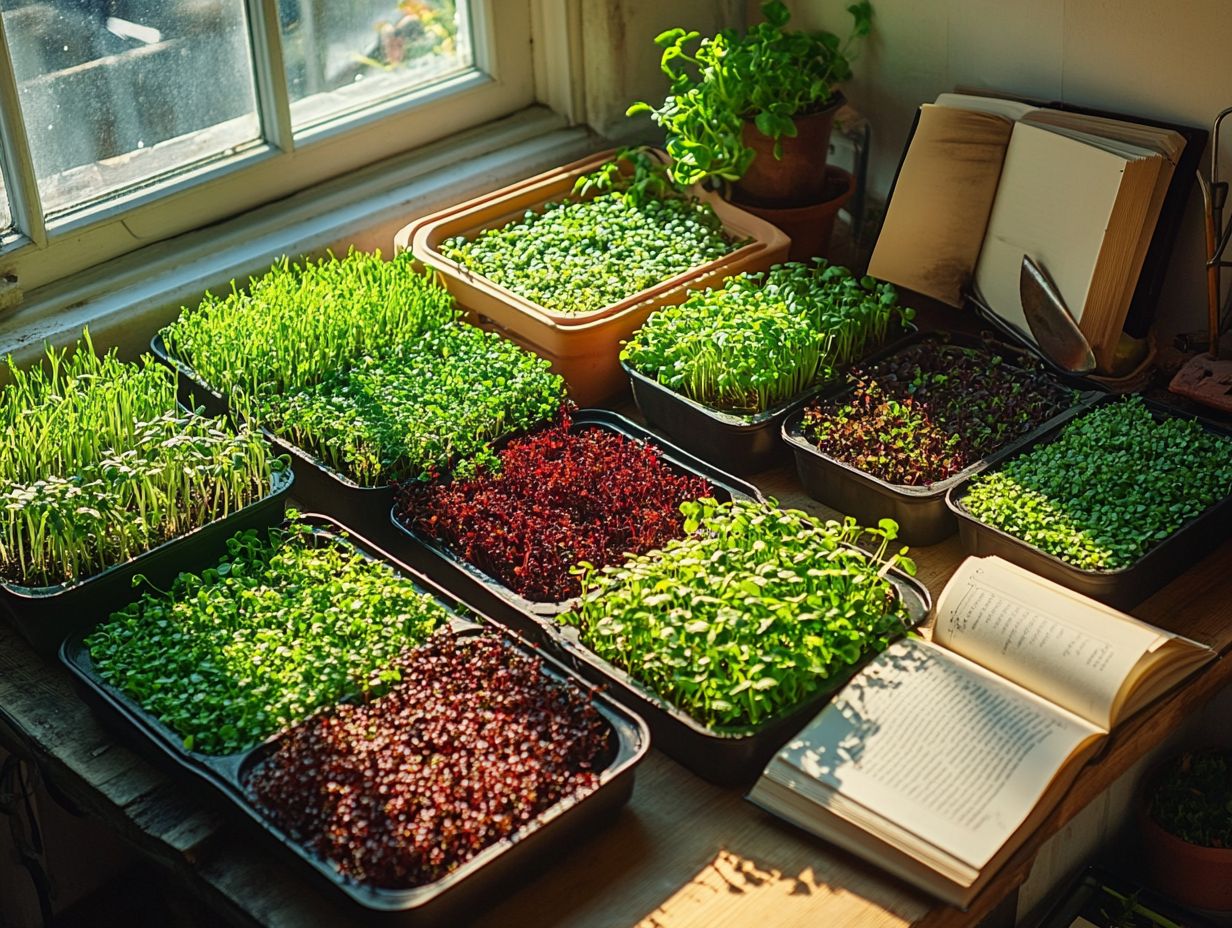
Exploring the finest microgreen growing books, like “Microgreens” by Lisa Welsch, offers invaluable insights into techniques, varieties, and recipes that can elevate your gardening expertise. Notably, Microgreens by Lisa Welsch highlights the importance of microgreen nutrients in your diet.
You can anticipate a thorough examination of essential growing methods, troubleshooting tips, and the nutritional benefits microgreens bring to a balanced diet.
Another outstanding resource, “The Tiny Greenhouse” by Michelle S. Spencer, uncovers innovative strategies to maximize small spaces and optimize your indoor gardening efforts.
Incorporating the latest research, these texts highlight best practices such as optimal lighting conditions and soil selection. Whether you’re a novice or a seasoned gardener, you’ll efficiently cultivate impressive microgreen harvests using essential tips for growing microgreens at home. By blending practical advice with contemporary findings, these books significantly advance the movement toward sustainable, home-based food production.
12. How to Incorporate Microgreens into Your Diet
These tiny, green powerhouses can truly elevate your everyday meals, transforming simple salads, soups, and sandwiches into gourmet experiences. For instance, imagine tossing a handful of sweet pea shoots into a classic lettuce salad for that perfect crunch, or adding peppery mustard greens to a savory omelet for an exciting flavor boost. You can easily elevate a cool summer gazpacho with a sprinkle of basil microgreens, introducing an aromatic twist that will leave your taste buds dancing when paired with edible flowers.
Adding microgreens to your meals is more than just cooking. It s a tasty and nutritious journey waiting for you. With a plethora of microgreen recipes at your fingertips, you can showcase their vibrant flavors and impressive health benefits, including the delightful addition of edible flowers.
By complementing these dishes with edible flowers, not only will you create a feast for the eyes, but you ll also introduce unique tastes and additional nutrients, turning every meal into a vibrant celebration of flavor and health.
13. Benefits of Growing and Eating Microgreens
Growing and consuming microgreens can elevate your healthy lifestyle with an impressive array of nutrients, flavors, and the ability to use them in many different dishes, making them an essential addition to your diet. Many best microgreens like Amaranthus and Broccoli provide essential nutrients that boost your health.
These petite greens are bursting with vitamins, minerals, and antioxidants that contribute to your overall wellness. They also boast potential disease-fighting properties, tackling inflammation and bolstering your immune system. Their vibrant hues and distinctive tastes can transform any dish, turning everyday meals into gourmet experiences.
Whether you sprinkle them atop a salad, blend them into smoothies, or use them as an eye-catching garnish, incorporating these nutrient-dense powerhouses into your culinary repertoire can invigorate both your health and your palate. They also connect nutrition and flavor delightfully.
14. Frequently Asked Questions about Microgreens
Frequently asked questions about microgreens encompass a variety of topics that pique the interest of home growers, ranging from cultivation techniques to the nutritional benefits of these tiny powerhouses. Resources like the Growing Microgreens Podcast can offer expert guidance on these topics.
These inquiries offer invaluable insights into the best practices for growing, selecting the right varieties, and maximizing their health benefits. You might find yourself pondering the ideal growing conditions light, temperature, and watering frequency that lead to a bountiful microgreens harvest. For a thorough understanding, check out this step-by-step guide to sowing microgreens. Perhaps you’re curious about effective pest control methods or the most delicious ways to incorporate these flavorful greens into your meals.
There are also common misconceptions about the nutrient levels in microgreens compared to their mature counterparts. By addressing this diverse array of concerns, you can cultivate a sense of confidence in your microgreen endeavors, giving you the power to enjoy the journey fully.
Frequently Asked Questions
What are microgreens?

What are microgreens?
Microgreens are young vegetable greens harvested just after sprouting. They are nutrient-dense and can enhance the flavor of salads, smoothies, and various dishes.
What are the best microgreen growing guides?
Some of the best microgreen growing guides include:
- “Microgreens: A Guide to Growing Nutrient-Packed Greens” by Eric Franks and Jasmine Richardson
- “The Complete Guide to Growing and Using Microgreens” by Fionna Hill
- “Microgreens: How to Grow Nature’s Own Superfood” by Fumio Tazawa
These guides cover topics such as growing microgreens at home and various microgreen recipes.
What are the best microgreen growing books?
Recommended microgreen growing books include:
- “The Sprouting Book: How to Grow and Use Sprouts to Maximize Your Health and Vitality” by Ann Wigmore
- “The Microgreens Cookbook: Nutritious, Flavor-Packed Recipes for Broccoli, Kale, Arugula, and More” by Nikhil Goyal
- “Microgreens: Growing and Eating Miniature Vegetables” by Mark Mathew Braunstein
These resources are excellent for anyone interested in exploring the potential of microgreen recipes.
What should I look for in a microgreen growing guide or book?
When choosing a microgreen growing guide or book, look for detailed instructions on:
- Which seeds to use
- How to plant them
- How to care for them
It’s also helpful to find guides that include information on the nutritional value of microgreens and recipes for using them in dishes, including those featuring edible flowers.
Can I find free microgreen growing guides and books online?
Yes, many free microgreen growing guides and books are available online. Reputable sources include:
- University extension websites
- Seed company websites, like Real Seeds
- Gardening blogs
Always evaluate the source to ensure the information is credible.
Are there any recommended courses or workshops for learning how to grow microgreens?
Yes, numerous courses and workshops are available for learning how to grow microgreens. Popular options include:
- Online courses from organizations like the Organic Farming Research Foundation
- In-person workshops at local garden centers or community centers
- Classes offered at botanical gardens or agricultural universities
These courses cover topics like indoor gardening and advanced techniques.


